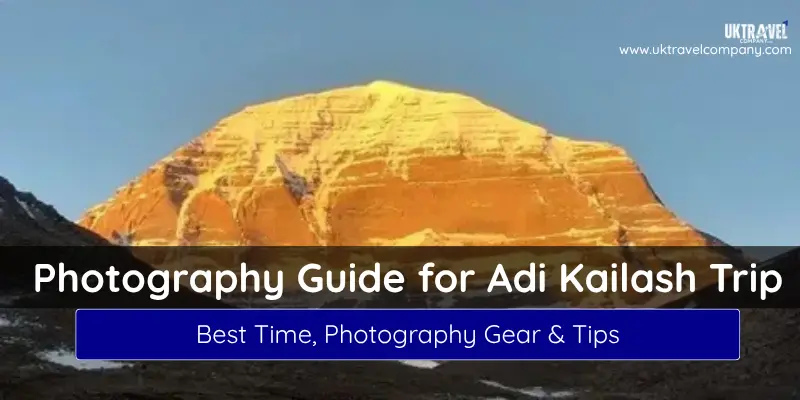Table of Contents
Introduction
Adi Kailash, also known as Chhota Kailash, is one of the most sacred and picturesque destinations in Uttarakhand, India. Surrounded by snow-capped peaks, serene lakes, and spiritual energy, it is often called the mirror image of Mount Kailash in Tibet. For photographers, Adi Kailash offers a rare opportunity to capture the perfect blend of natural beauty and spiritual devotion. However, photographing this divine land requires more than just a camera—it demands the right timing, perspective, and respect for the environment.
In this article, we will explore the best photography tips For Adi Kailash Yatra, making your journey both memorable and visually stunning.
Best Time to Visit for Photography
The best time to capture Adi Kailash is during the summer (May–June) and autumn (September–October) seasons.
- Summer: Clear skies, green landscapes, and accessible trails.
- Autumn: Crisp air, colorful scenery, and golden lighting conditions.
Avoid the monsoon months (July–August) due to heavy rains and landslides.
The golden hour—just after sunrise and before sunset—offers the most dramatic light, highlighting the snowy peaks and reflecting colors across the valleys.
Essential Photography Gear for Adi Kailash
Since Adi Kailash is a remote region, carrying the right gear is crucial.
- Camera: A DSLR or mirrorless camera ensures better quality, though modern smartphones with advanced cameras can also work well.
- Lenses: A wide-angle lens for sweeping landscapes and a telephoto lens for distant peaks and wildlife.
- Tripod: Essential for stability, especially during sunrise, sunset, or low-light photography.
- Accessories: Extra batteries, memory cards, polarizing filters, and a waterproof camera bag for safety.
Photography Tips to Capture the Beauty of Adi Kailash
1. Framing the Majestic Peaks
Use natural elements like rivers, forests, and prayer flags in the foreground to create depth. Wide-angle shots are ideal for showcasing the vastness of the mountains.
2. Playing with Light and Shadows
Mountains look different throughout the day. Early morning soft light and evening golden tones add magic to your photos. Shadows on the snow add natural contrast and texture.
3. Capturing Pilgrimage Moments
Adi Kailash is not only about landscapes but also about spiritual experiences. Capture devotees walking the trail, local rituals, or people tying prayer flags. Always get someone’s consent before taking a close-up of them.
4. Focusing on Details
Look beyond the mountains. Capture the colorful prayer flags, wooden houses, ancient temples, rare flowers, and local wildlife. These details enrich the story of your photography journey.
5. Landscape Composition Techniques
- Apply the rule of thirds for balanced images.
- Use leading lines such as rivers, valleys, or trekking paths to guide the viewer’s eyes.
- Try panoramic shots for vast Himalayan landscapes.
Explore Our Adi Kailash & Om Parvat Yatra Packages
Adi Kailash Yatra Package From Dharchula
Adi Kailash Yatra Package From Delhi
Adi Kailash Yatra Package From Kathgodam, Haldwani
Adi Kailash Yatra Package From Pithoragrah
Ethical Photography in Adi Kailash
- Always respect local culture and traditions—avoid intrusive photography during prayers.
- Drone photography may be restricted; check regulations before flying.
- Practice eco-friendly photography: don’t disturb nature, avoid littering, and leave no trace.
Post-Processing Tips
After capturing, enhance your photos using simple editing tools:
- Adjust brightness, contrast, and sharpness for clarity.
- Boost colors slightly, but avoid over-editing that makes landscapes look unnatural.
- Cropping can help improve framing without losing the essence.
Conclusion
Photography at Adi Kailash is more than just capturing landscapes—it is about documenting the harmony of nature and spirituality. With the right gear, timing, and respect for local traditions, you can create photographs that truly reflect the divine aura of this sacred Himalayan destination. Remember, the real beauty of Adi Kailash lies not only in pictures but also in the peace and energy it offers to every traveler.
FAQs On Photography Tips For Adi Kailash Yatra
What is the best camera setting for Adi Kailash photography?
Use a wide-angle lens for landscapes, low ISO for clear shots, and a tripod for stability in low light
Can I capture sunrise and sunset at Adi Kailash?
Yes, both sunrise and sunset are perfect for capturing the golden glow on the snow-covered peaks.
Do I need special permits for photography in Adi Kailash?
You need permits for the Yatra itself, but no special permit for photography unless you use drones



